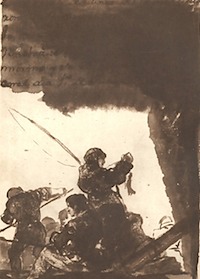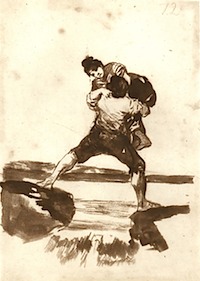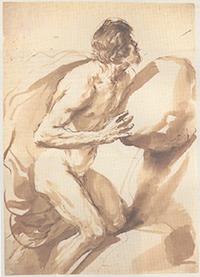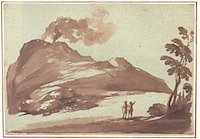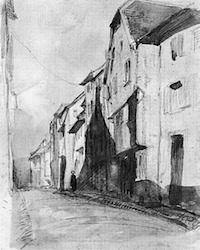Sketchbook Week 4: Shape of Value and Proportion
Four Drawings
Subject: Landscape
Materials: 9"x11 3/4" Strathmore paper, 2H graphite pencil, India Ink, sumi and white nylon brushes (round and flat), View Catcher.
You will continue developing your sensitivity to the relationship of shapes within a given spatial context that began last week with positive and negative space. This week you will be working with the relationship of shapes of similar values regardless of placement in space (foreground, middle-ground, background) and the compositional dynamic that can be created with your organization of them. This process is not just an exercise; there are numerous examples of drawings from Western and Eastern cultures and from a broad spectrum of history that have been created following this procedure. Thinking in the connective manner encouraged by this process will increase the expressive potential of your work. Understanding this process is key to your becoming fluent with the language of visual art; this is not something that you fully develop in one exercise. As with any part of the material we cover, it will take repeated practice now and in the future.
You will have a shorter time period to work on Drawings #1-3 and will not be able to get all of the information in that you might see. That is expected. Drawing #4 is much longer in duration and will give you ample time to develop some of the smallest units of value that you see in your subject.
Drawing #1 (this will be started during our class meeting time)
1) 2H graphite pencil and diluted ink, nylon brushes. Lightly draw a 1"x10" rectangle divided into 1" units on one of the 11" edges of your paper. Avoid heavy outlines around the squares; this will give the opportunity to create a gradation of values from black to white, which is the goal of this drawing. The tenth square is to be white. Beginning with the ninth square and using a diluted mixture of ink that equals a gray one step darker than your white square, lay in an even wash in squares 9-1; use your flat brush from Foundation Design I class for this.
2) Diluted ink and nylon brushes. Mix a gray wash that will dry one step darker in value than what you have in the ninth square. Apply that wash in squares 1-9.
3) Diluted ink and nylon brushes. Mix a gray wash that will dry one step darker in value than what you have in the eighth square; apply that wash in squares 1-8.
4) Diluted ink and nylon brushes. Mix a gray wash that will dry one step darker in value than what you have in the seventh square; apply that wash in squares 1-7.
5) Diluted ink and nylon brushes. Mix a gray wash that will dry one step darker in value than what you have in the sixth square; apply that wash in squares 1-6.
6) Diluted ink and nylon brushes. Mix a gray wash that will dry one step darker in value than what you have in the fifth square; apply that wash in squares 1-5.
7) Diluted ink and nylon brushes. Mix a gray wash that will dry one step darker in value than what you have in the fourth square; apply that wash in squares 1-4.
8) Diluted ink and nylon brushes. Mix a gray wash that will dry one step darker in value than what you have in the third square; apply that wash in squares 1-3.
9) Diluted ink and nylon brushes. Mix a gray wash that will dry one step darker in value than what you have in the second square; apply that wash in squares 1-2.
10) Black ink and nylon brushes. Use full strength ink and fill in the first square with it, so you have a solid black. Beginning with the first square, you should have a gradual gradation of values from black to white; this should match your printed ten-step value scale from Art 125. 60-90 minutes.
Drawing #2
1) Look for a subject on campus or in the surrounding community that you feel has a visually interesting relationship of value shapes. Use your View Catcher as an aid in deciding how to crop in on your subject.
2) Begin your drawing using a 2H graphite pencil, held in the open manner, and lightly define the directional forces. Continue with sighting angles establishing proportional relationships of the shapes in relation to one another. 15 minutes.
3) Dilute some ink with water so that it matches value 5 on your ink wash value scale (completed in class). Continue with using the scale as a comparative device, fill in every shape with your gray wash that falls into the range of values 7-1. Let it fully dry. 15 minutes.
4) Identify all shapes that match values 3-1 on your value scale. Complete the drawing by filling in all of those shapes with a value 2. 10-15 minutes.
Drawing #3
1) Follow steps 1-4 in Drawing #2, using a different landscape view; you can work in the same area, but you cannot repeat the same compositional cropping.
Drawing #4
1) Follow steps 1-2 from Drawing #2. 15 minutes.
2) Continuing to work with your 2H pencil, give yourself more time to develop more detail with the smaller value shapes that you see. 10 minutes.
3) Follow step 3 in Drawing #2, but give yourself more time. 25 minutes.
4) Follow step 4 in Drawing #2. 15 minutes.
